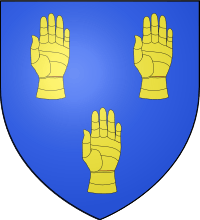Baron Barnard

Baron Barnard, of Barnard Castle in the Bishopric of Durham, is a title in the Peerage of England. It was created in 1698 for Christopher Vane, who had previously served as a Member of Parliament for County Durham and Boroughbridge. Vane was the son of Sir Henry Vane the Younger and grandson of Sir Henry Vane the Elder. His grandson, the third Baron, notably served as Paymaster of the Forces and as Lord Lieutenant of County Durham. In 1754 he was created Viscount Barnard, of Barnard Castle in the County of Durham, and Earl of Darlington, in the County of Durham. Lord Darlington was the husband of Lady Grace FitzRoy, daughter of Charles FitzRoy, 2nd Duke of Cleveland, the illegitimate son of King Charles II by his mistress Barbara Villiers, 1st Duchess of Cleveland.
He was succeeded by his son, the second Earl. He sat as a Member of Parliament for Downton and County Durham and served as Lord Lieutenant of County Durham. On his death the titles passed to his son, the third Earl. He represented Totnes and Winchelsea in Parliament and served as Lord Lieutenant of County Durham. In 1827 the Cleveland title held by his great-grandmother was recreated when he was made Marquess of Cleveland, and in 1833 the dukedom of Cleveland was also revived when he was created Baron Raby, of Raby Castle in the County of Durham, and Duke of Cleveland. In 1839 the Duke was given the additional honour of being made a Knight of the Garter.
He was succeeded by his eldest son, the second Duke. He was a general in the army and also sat as a Whig Member of Parliament for County Durham, Winchilsea and Totnes and as a Tory for Saltash and South Shropshire. When he died the titles passed to his younger brother, the third Duke. He represented Winchelsea and County Durham in the House of Commons as a Whig and St Ives and Ludlow as a Tory. In 1813 he assumed by Royal Licence his mother's maiden name of Powlett but in 1864, on succeeding to the dukedom, he resumed by Royal Licence his patronymic Vane. He was childless and was succeeded by his younger brother, the fourth Duke. He was in the Diplomatic Service and also a Liberal Member of Parliament for South Durham and Hastings. In 1864 he assumed by Royal Licence his mother’s maiden surname of Powlett in lieu of Vane. Like his two elder brothers he was childless and on his death 1891 the barony of Raby, the viscountcy, earldom, marquessate and dukedom became extinct,
However, he was succeeded in the barony of Barnard, according to a decision by the Committee for Privileges of the House of Lords in 1892, by his distant relative Henry de Vere Vane, who became the ninth Baron. He was the great-great-grandson of Hon. Morgan Vane, younger son of the second Baron. His second son, the tenth Baron, was Lord Lieutenant of County Durham. The latter's son, the eleventh Baron, succeeded in 1964 and served as Lord-Lieutenant of County Durham from 1970 to 1988. As of 2016 the title is held by the latter's son, the twelfth Baron.[2]
Two other members of the Vane family have been elevated to the peerage. Hon. William Vane, younger son of the first Baron Barnard, was made Viscount Vane in the Peerage of Ireland in 1720 (see this title for more information). Also, William Vane, nephew of the ninth Baron, was created Baron Inglewood in the Peerage of the United Kingdom in 1964 (see this title for more information).
The family seat is Raby Castle, near Staindrop, County Durham.
Barons Barnard (1698)
- Christopher Vane, 1st Baron Barnard (1653–1723)
- Gilbert Vane, 2nd Baron Barnard (1678–1753)
- Henry Vane, 3rd Baron Barnard (c. 1705–1758) (created Earl of Darlington in 1754)
Earls of Darlington (1754)
- Henry Vane, 1st Earl of Darlington, 3rd Baron Barnard (c. 1705–1758)
- Henry Vane, 2nd Earl of Darlington, 4th Baron Barnard (1726–1792)
- William Henry Vane, 3rd Earl of Darlington, 5th Baron Barnard (1766–1842) (created Duke of Cleveland in 1833)
Dukes of Cleveland (1833)
- William Henry Vane, 1st Duke of Cleveland, 5th Baron Barnard (1766–1842)
- Henry Vane, 2nd Duke of Cleveland, 6th Baron Barnard (1788–1864)
- William John Frederick Vane, 3rd Duke of Cleveland, 7th Baron Barnard (1792–1864)
- Harry George Powlett, 4th Duke of Cleveland, 8th Baron Barnard (1803–1891)
Barons Barnard (1698; Reverted)
- Henry de Vere Vane, 9th Baron Barnard (1854–1918) (claim admitted 1892)
- Hon. Henry Cecil Vane (1882–1917)
- Christopher Vane, 10th Baron Barnard (1888–1964)
- (Harry) John Neville Vane, 11th Baron Barnard (1923–2016)
- Henry Francis Cecil Vane, 12th Baron Barnard (b. 1959)
The heir apparent is the present holder's son the Hon. William Henry Cecil Vane (b. 2005).
See also
Notes
- ↑ Debrett's Peerage, 1968, p.115, which omits appaumée, useful in differentiating from Fane arms; concerning appaumée Cussans (1898) states: "In blazoning a Hand, besides stating what position it occupies, and whether it be the dexter or sinister, and erased or couped, it must be mentioned whether it be clenched or appaumé". (Cussans, John, Handbook of Heraldry, 2nd Edition, London, 1868, p.47, p.92)
- ↑ Lord Barnard dies aged 92
References
- Kidd, Charles, Williamson, David (editors). Debrett's Peerage and Baronetage (1990 edition). New York: St Martin's Press, 1990,
- Leigh Rayment's Peerage Pages
